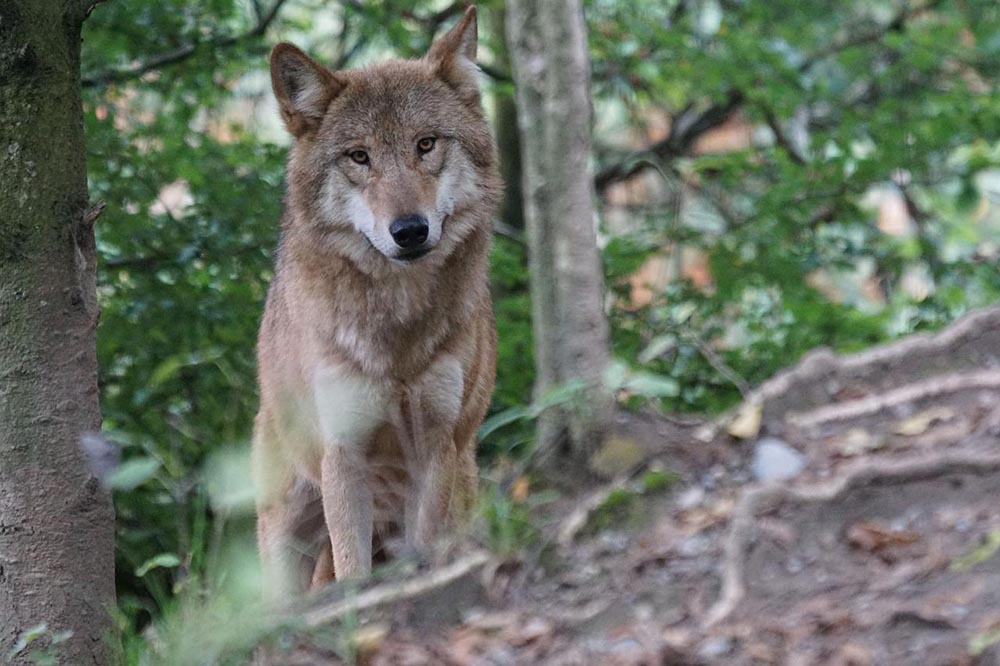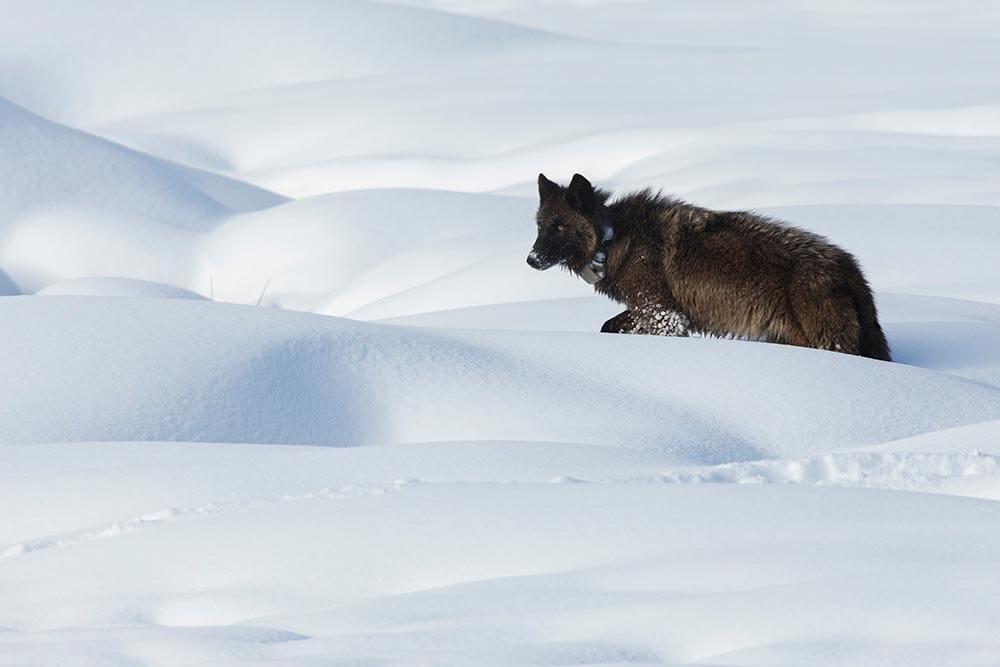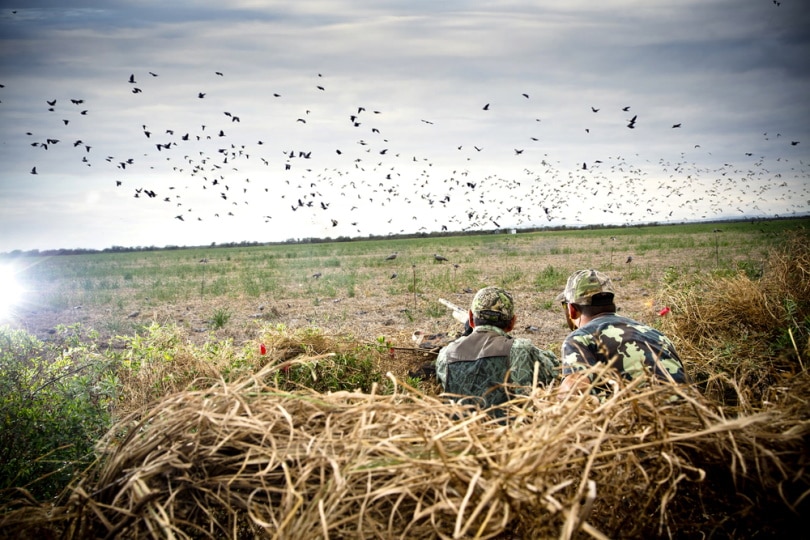How To Hunt Wolves – 10 Basic Tips & Tricks
Last Updated on

Wolf hunting is a practice that’s almost as old as time. These animals have been hunted for close to 10,000 years, for various reasons. Some communities hunted them for sport, some to protect their livestock, and others to guarantee the survival of their people. That’s why their population drastically decreased to the point where we had to enlist them as endangered.
Before we get started, we feel obligated to let you guys know that this topic has been a polarizing issue for quite a while. Anyone active in this community will tell you they’ve been trading blows with anti-hunting groups and conservationists for what feels like eons.
And it’s easy to see their point of view, seeing as nobody really wants to live on a planet that doesn’t have a single wolf species. All we ask of them is to understand that wolf harvest is more of a management strategy to ensure that they don’t propagate to the extent they overwhelm our people.
Now that that’s out of the way, let’s get down to business.

How To Hunt Wolves – 10 Basic Tips & Tricks
1. Follow the elk

Wolves love bison more than they do elk. But they know they have to be a really strong pack to hunt down a bison, or else they’ll be overpowered. So to avoid the hassle, they always settle for the next best thing—the elk.
What makes elk the ideal prey is their relatively small size, and non-aggressive nature. Of course, they’ll put up a fight when attacked, but not the way the bison would. In addition, a mature elk will guarantee a setting for an entire pack, which usually consists of up to 10 wolves.
So instead of tracking the wolf, track its food. Look for a herd that’s oblivious to what’s happening around them, because that’s when the predator strikes. If there are no elk in your state, but the white-tailed deer is a native, go to their yarding areas.
You can also keep an ear to the ground for information on livestock owners grappling with wild animal attacks. Chances are, there are wolves causing problems in those areas.
2. Pattern the animal

We don’t know if you knew this, but all game animals can be patterned. Even though some of them are sly, at the end of the day, all animals are creatures of habit. No matter how hard they try to avoid certain routes, they’ll still create a new pattern and end up using the same crossings or travel routes.
According to wolf biologists, this species prefers taking easy paths. So don’t be shocked if you find them using the same trails you use daily, or on roads. And if a lake’s frozen, they’ll cross it instead of going around it.
It’s important to note that some wolves are just naturally reclusive. They won’t be seen in public even if they are tracking prey. The only way to lure such an animal onto open ice is to bait them.
3. Get a permit

Are you going to hunt on private land or public property? If it’s private, you’ll need to get permission from the property owner. You cannot just start shooting things on a property that’s not in your name because that’s trespassing. If the landowner feels threatened for some reason and inadvertently shoots you, they won’t be prosecuted.
And by the way, we came to learn that most private landowners love making friends with people who share their interests. They’ll be happy to hunt with you, and maybe even introduce you to some of their hunting buddies.
If the land is public, you’ll need to talk to the local authorities first. They’ll walk you through the rules and regulations, including the daily and possession limits.
4. Never shoot a collared wolf

Shooting a collared wolf is a cardinal sin in this community. And that’s because it takes a lot of time and money to collar a single wolf to make it easier for hunters to track its pack.
There’s also another silent rule that nobody really talks about, as we often like to assume that everyone involved will use their common sense. It’s about the gender that you’re supposed to be hunting.
Given we’re all about population control, we usually go for the females and not the big trophy male. That way, you’ll be taking out an animal that can birth four to six pups in a breeding season.
5. Exclusively hunt wolves

We’ve seen hunters go out to hunt elks, deer, or doves, only to change their minds in between the hunt, and go for wolves. That’s dangerous because you won’t have the right gear required to protect yourself if anything goes wrong, or mental space.
To top that off, wolf hunting strategies are way different from the kind used on other game animals. they could backfire and land you into trouble.
6. Weapon choice

Any weapon that’s legal in the United States can be used to hunt a wolf. The most common weapons that we’ve seen hunters use before are shotguns, muzzleloaders, rifles, crossbows, and compound bows.
7. Hunting methods

You have to psychologically prepare yourself before going out there. Wolf hunting is no walk in the park, even for a hunter who has years of experience under his/her belt. A large number of wolves that have been taken in, according to official reports, are those that were trapped.
These are the methods used in most states:
- Blind & Bait: All you need is bait and a pop-up blind or box that will cover it. You have to place it 200 to 300 yards away from you, as wolves are intuitive animals. they’ll sense something’s amiss from a mile away.
- Kill site: Remember when we told you all animals are creatures of habit? Well, in the case of a wolf, it will return to the same spot it killed its prey. And you’ll know they’ve been around since they always leave carcasses behind.
- Calling: For this method to work, you first have to acquaint yourself with the fauna in the area. It’s not smart to mimic the distress call of an elk, in an area that’s primarily inhabited by the white-tailed deer. You also have to check in with the local authorities, to be sure you’re not infringing on any law by using electronic calls.
- Dogs: It’s prohibited to hunt wolves with dogs in all states except Wisconsin. They allow up to six dogs, but hunters in that state prefer using one. The dogs are normally trained to pick up a scent and track the animal to its hideout.
8. Set up on high ground

Instinctively, you’ll want to set yourself up in a depression, trench, or hole. Fight that urge, as it’s a terrible idea. You should either use a treestand to increase your visibility or set up on high ground. Believe us when we say, you don’t want to be surprised by an animal that literally runs faster than a dog. Your chances of survival will be minimal.
9. Bad weather days are the best hunting days

Wolves are usually reckless while tracking their prey in bad weather. Especially when it’s snowing or drizzling. So if you wish to bag your first hunt, that’s the best time to go out there. Just don’t forget you’ll also be vulnerable, the same way they are.
10. Pay attention to the birds

Have you noticed there’s an area that has a lot of ravens, gray jays, or magpies? They are probably stalking a fresh kill, waiting for the wolf to leave. Approach that area with caution and try to be quiet. You don’t want to spook a pack—or end up being dinner!

Frequently Asked Questions
Is wolf meat edible?
Yes, it is. The only reason why you don’t see a lot of people eating it is that for generations we’ve seen wolves as nothing more than apex predators. Nobody in their wildest dreams ever thought the hunter would one day become the hunted. Until someone tried it, and realized the meat is safe and flavorful when harvested and prepared properly.
Does wolf meat taste like chicken?
It sometimes does, but other times it tastes like pork. These variations in taste are a result of a combination of factors, including the age of the animal, the climate of the region, the food it eats, and the water it drinks.
Young wolves taste like chicken, while older ones taste like pork. And if the region experiences a cooler climate for the most of the year, the meat will be tender. If you can’t quite place the taste, you’ve probably prepared the meat of an aging wolf. It’s either that or the wolf couldn’t access a proper diet.
What’s the nutritional value of wolf meat?
It doesn’t really hold any significant nutritional value when it’s raw. But once it’s been cooked, the cholesterol level will be around 70.2mg, fat 0.6g, and protein 30g. Wolf meat doesn’t offer carbohydrates. Therefore, if your relationship with that macronutrient is stoic at best, you can prepare it as a substitute.
•You might also like: How To Get Rid of Starlings: 16 Tips and Tricks

Final Thoughts
The fact that wolf meat is considered exotic means you’ll have to pay a lot of money to try it. And that’s only if you’re fortunate enough to find a store or a restaurant that sells it. Most people don’t like preparing it simply because they believe it’s not safe for consumption.
Hunting is always an option, but you have to find someone who’ll show you the ropes. Remember to get the required permits or permission, the correct gear, and most importantly, be careful!
See also:
Featured Image Credit: Pixel-mixer, Pixabay
About the Author Robert Sparks
Robert’s obsession with all things optical started early in life, when his optician father would bring home prototypes for Robert to play with. Nowadays, Robert is dedicated to helping others find the right optics for their needs. His hobbies include astronomy, astrophysics, and model building. Originally from Newark, NJ, he resides in Santa Fe, New Mexico, where the nighttime skies are filled with glittering stars.
Related Articles:
How to Collimate Binoculars: 9 Expert Tips
How to Clean a Refractor Telescope: Step-by-Step Guide
How to Clean a Telescope Eyepiece: Step-by-Step Guide
How to Clean a Rifle Scope: 8 Expert Tips
When Were Binoculars Invented? History, Today & Future
Can You Use Binoculars to Look At Stars? How to Choose the Right Pair
How to Choose Binoculars for Bird Watching: 10 Expert Tips
Monocular vs Telescope: Differences Explained (With Pictures)
